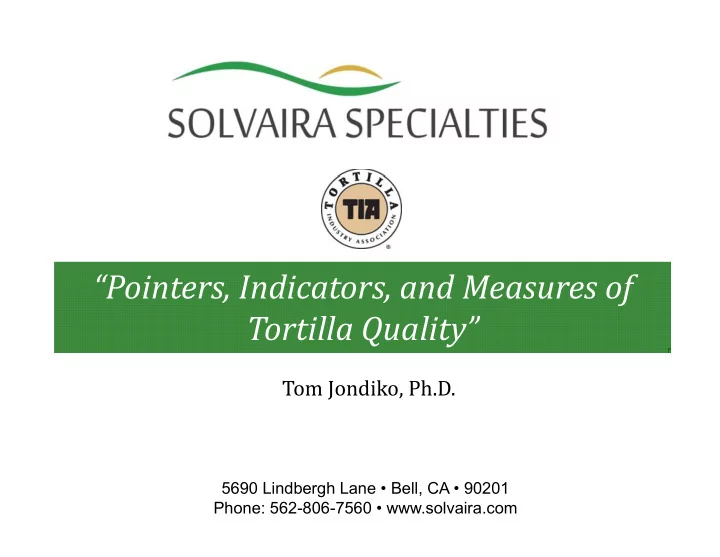

“Pointers, Indicators, and Measures of Tortilla Quality” Tom Jondiko, Ph.D. 5690 Lindbergh Lane • Bell, CA • 90201 Phone: 562-806-7560 • www.solvaira.com
Tortilla Quality Consumers perspective: • The definition of a good quality tortilla encompasses the ability to retain its flexibility, remain strong so there is no cracking or tearing, and of course, taste good. (Waniska et al 2004, Jondiko et al 2016). Tortilla Producers perspective: • Quality includes uniform shapes, toast marks, soft, fluffy, adequate shelf life for distribution and sales. Overall perspective: • Quality = Quality raw material + Quality processing + Quality of personnel.
Tortilla Form ula Com position Batch Pack: Salt, Sugar, Leavening Dough Conditioners & Preservatives 5.0% 6.0% 29.0% 60.0% Flour Water Shortening Batch Pack
Defining Quality Tortillas must meet consumer expectations. • Physical parameters (Soft, pliable). • Good diameter, uniform, toast marks and long shelf life.
Flour: Starch Quality • Good quality tortillas produced using wheat flour of intermediate protein and low level of starch damage (Waniska et al 2004) . Starch characteristics: – Measured using rapid visco analyzer. – Peak and final viscosity. – Affect cooking conditions. – Tortilla flexibility. – Tortilla shelf stability.
New Flour Starch Quality Pastry Flour New Flour 1 New Flour 2 All purpose High Protein James Chapa 2016, Solvaira R&D • Evaluate quality of new flour compare to standard. • Starch is gelatinized causes rise in viscosity. • Tortillas start sticking on each other.
Protein Quality vs Quality Protein Content • Good quality can be produced using wheat flour of intermediate protein content (Waniska et al 2004). Protein content is not an adequate indicator of tortilla quality • Protein content can not simultaneously predict both diameter and rollability LU 2.5 • Look at protein fractions? 2.25 2.0 1.75 Absorbance at 210 nm 1.5 1.25 1.0 10 15 20 25 LU 1.4 1.3 1.2 1.1 1.0 0.9 0.8 25 10 15 20 Elution time (min)
Flour protein fraction and tortilla quality • Wheat protein fractions in gluten play a significant role in tortilla making (Jondiko et al. 2012) • Variation of flour protein molecules can improve tortilla quality. • Tortilla diameter can be predicted using a protein molecule content and dough rheological properties • Tortilla softness depends on the ratio of the gluten protein molecules Parameter Range Glutenin: Gliadin Ratio 0.5 – 0.9 Mono & Polymeric proteins 12 – 65 HMW & LMW – GS 0.3 -0.6
Total Protein content and Functionality Relationship of tortilla diameter, flexibility & flour protein Acceptable Good Flexibility Diameter Small diameter Flexibility Not Acceptable: Not Acceptable: Falling apart Very week, sticky and sticking dough, brittle tortillas
Gluten Acid Test Correlation Between Protein Content and Viscosity at 3 minutes Measured in the Wheat Gluten Acid Tests 14 High Protein 13 Flour y = 0.0028x + 7.9225 Protein Content (%) R² = 0.9948 12 All Purpose All Purpose Flour 1 11 Flour 2 New High Protein 10 Flour Samples 9 Pastry Flour James Chapa 2016, Solvaira R&D 8 250 450 650 850 1050 1250 1450 1650 1850 2050 Viscosity (cP) • New High protein flour 13% total protein has only 11% functional protein • Can result in tortilla quality defects • Evaluate the functionality of new flour when received
Gluten Quality: Viscosity & Tem perature High Protein Flour All Purpose Flour New Protein Flour Pastry Flour James Chapa 2016, Solvaira R&D Quality variation: Higher viscosity means higher gluten quality Tortilla Sticking Oven temperature adjustment
Functional Protein Content & Flexibility Intermediate Functional Protein Content (10.5 % – 12.0%) Low Functional Protein Content (8.0 – 10.5% )
Predicting Flour Functionality for Tortillas Area F_25 1) Prediction value > or = 0: Suitable flour for quality tortilla 2) Prediction value < = 0: Unsuitable for good tortilla Good Rollability and Diameter = -10.15 – 0.19*Weight + 10.58Glu:GliRatio – 0.05*IPP – 0.22*Area + 1.4*F_25 + 0.36*F_100 + 0.02*CompForce;
Water Quality • The second largest component of tortillas. • Optimum tortilla moisture content: 29 – 32% affects: – Tortilla Texture – Shelf‐life – Excess water create steam and weakens tortilla structure • Monitor microbial counts on water used. • Water temperature of used to make dough. • Water pH: – Depending source water can be treated to adjust pH hence measure pH regularly – Measure conductivity to determine hardness
Shortening/ Fat Quality An important component of tortillas • Type used: – liquid oil – Solid shortening • Affect tortilla texture: – Slow staling – Interact with flour components – starch & protein • Improves dough machinability & reduce stickiness • Provide desired flavor in tortillas • Prevents & reduces tortilla sticking during storage
Functional Ingredients Raw Material Quality: Bake tests for functionality Test for pH, CO2, Sodium, moisture Sticking test Microbial loads Flexibility, & Accelerated Shelf life Particle Size distribution Purity tests
Processing and storage conditions • Temperature reduction after baking, during packaging, in transportation and in storage. • Monitor and document parameters: – Dough mixing – Dividing & rounding – Pressing method – hand stretch, hot press or die cut – Oven – Cooling – Packaging
Other aspects of shelf stability • pH: Ideal between 5.2 – 5.8 flour tortillas. • Preservatives: Sorbates and propionate effective at low pH where as Parabens at high pH (Questions around safety of Parabens). • Microbial load: Establish & monitor COA limits for all suppliers.
Conclusion The recipe to deliver good quality tortillas Quality of Flour. Quality of Water. Quality of Shortening/ Oil Quality of functional ingredients. Quality of personnel: qualification, training &continuous improvement. Consistent documentation and monitoring of data.
Recommend
More recommend